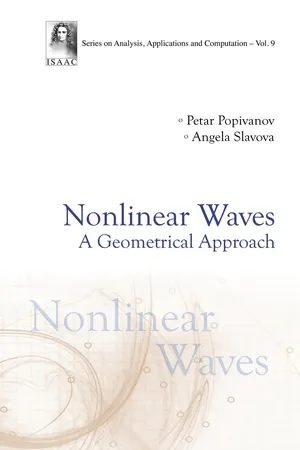
- 208 pages
- English
- ePUB (mobile friendly)
- Available on iOS & Android
About this book
This volume provides an in-depth treatment of several equations and systems of mathematical physics, describing the propagation and interaction of nonlinear waves as different modifications of these: the KdV equation, Fornberg–Whitham equation, Vakhnenko equation, Camassa–Holm equation, several versions of the NLS equation, Kaup–Kupershmidt equation, Boussinesq paradigm, and Manakov system, amongst others, as well as symmetrizable quasilinear hyperbolic systems arising in fluid dynamics.
Readers not familiar with the complicated methods used in the theory of the equations of mathematical physics (functional analysis, harmonic analysis, spectral theory, topological methods, a priori estimates, conservation laws) can easily be acquainted here with different solutions of some nonlinear PDEs written in a sharp form (waves), with their geometrical visualization and their interpretation. In many cases, explicit solutions (waves) having specific physical interpretation (solitons, kinks, peakons, ovals, loops, rogue waves) are found and their interactions are studied and geometrically visualized. To do this, classical methods coming from the theory of ordinary differential equations, the dressing method, Hirota's direct method and the method of the simplest equation are introduced and applied. At the end, the paradifferential approach is used.
This volume is self-contained and equipped with simple proofs. It contains many exercises and examples arising from the applications in mechanics, physics, optics and, quantum mechanics.
Contents:
- Introduction
- Traveling Waves and Their Profiles
- Explicit Formulas to the Solutions of Several Equations of Physics and Geometry
- First Integrals of Systems of ODE Having Jump Discontinuities
- Introduction to the Dressing Method and Application to the Cubic NLS
- Direct Methods in Soliton Theory. Hirota's Approach
- Special Type Solutions of Several Evolution PDEs
- Regularity Properties of Several Hyperbolic Equations and Systems
Readership: University and graduate students, mathematicians, physicists, engineers and specialists in the fields of evolution PDEs and their applications.Partial Differential Equations in Mathematical Physics;Traveling Waves;Solitons;Kinks;Loops;Ovals and Peakon Types;Nonlinear Waves;Rogue Waves;Evolution PDEs;Interaction of Waves;Dressing Method and Hirota's Direct Method in Studying Nonlinear Waves;Method of the Simplest Equation;Exact Solutions;Geometrical Visualization of Nonlinear Waves;Rational Solutions;Propagation of Waves and New Born Waves;Wave Front Sets of the Solutions of Nonlinear Systems of PDEs;Regularizing Properties of the Solutions of Dissipative Semilinear PDEs0 Key Features:
- Contains a competent introduction to different methods for solving and studying the properties of several evolution PDEs, namely, method of characteristics and first integrals, method of the simplest equation, dressing method, Hirota's direct method and paradifferential method
- All the solutions, their interaction and new born waves are geometrically illustrated and interpreted by 45 figures
- The treatment is self-contained and aims to accustom the readers to work on their own by including in the book a lot of examples and exercises
Frequently asked questions
- Essential is ideal for learners and professionals who enjoy exploring a wide range of subjects. Access the Essential Library with 800,000+ trusted titles and best-sellers across business, personal growth, and the humanities. Includes unlimited reading time and Standard Read Aloud voice.
- Complete: Perfect for advanced learners and researchers needing full, unrestricted access. Unlock 1.4M+ books across hundreds of subjects, including academic and specialized titles. The Complete Plan also includes advanced features like Premium Read Aloud and Research Assistant.
Please note we cannot support devices running on iOS 13 and Android 7 or earlier. Learn more about using the app.
Information
Chapter 1
Introduction
1.1.Introduction


Table of contents
- Cover
- Halftitle
- Series Editors
- Title
- Copyright
- Preface
- Contents
- 1. Introduction
- 2. Traveling waves and their profiles
- 3. Explicit formulas to the solutions of several equations of physics and geometry
- 4. First integrals of systems of ODE having jump discontinuities
- 5. Introduction to the dressing method and application to the cubic NLS
- 6. Direct methods in soliton theory. Hirota’s approach
- 7. Special type solutions of several evolution PDEs
- 8. Regularity properties of several hyperbolic equations and systems
- Bibliography
- Index